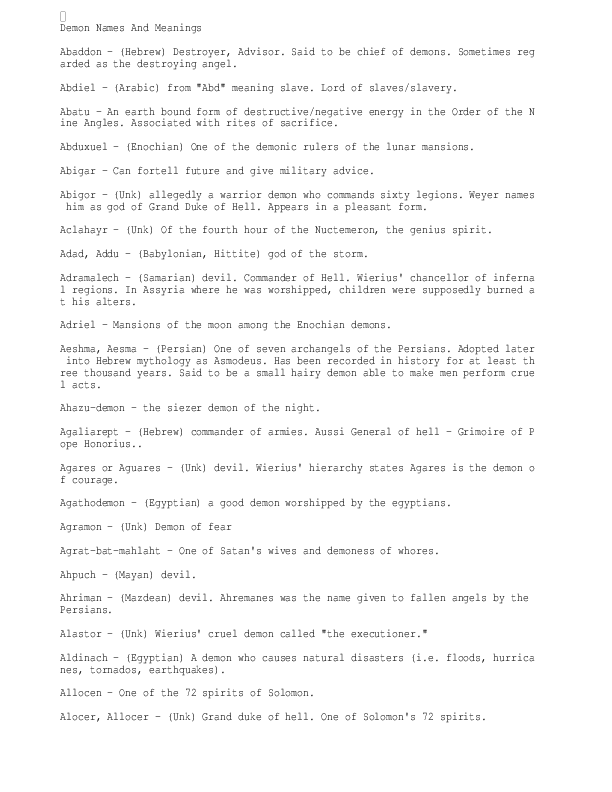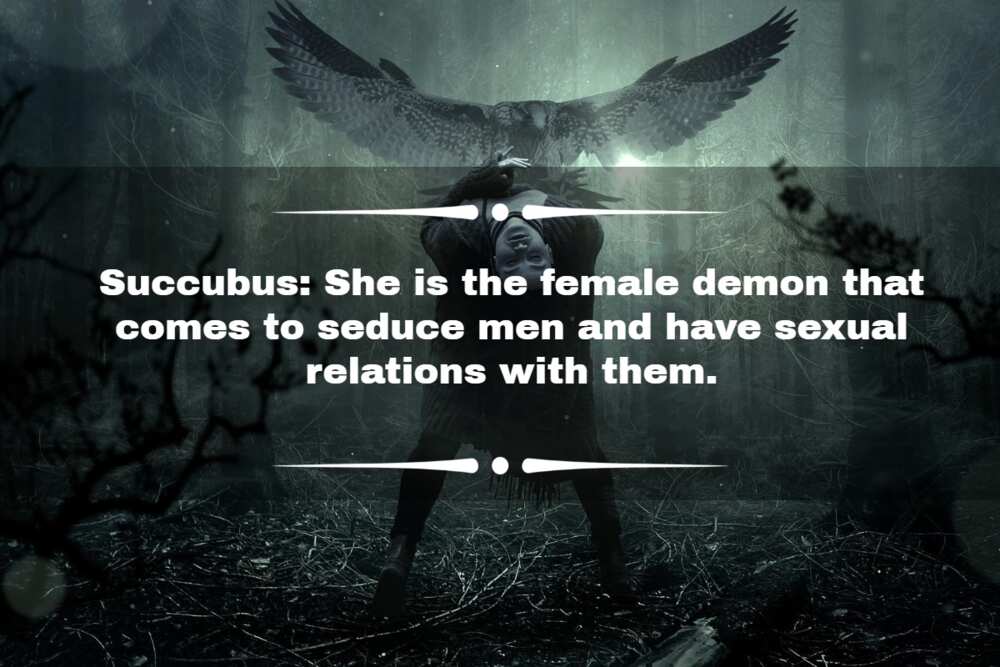Female Demon Names And Their Hidden Meanings: A Dark And Intriguing Journey
Ever wondered what lies beneath the shadows of the underworld? Female demons, with their enchanting names and mysterious meanings, hold secrets that have fascinated humanity for centuries. From ancient texts to modern lore, these names carry power, history, and a touch of the supernatural. Whether you're a lore enthusiast, a writer seeking inspiration, or just plain curious, this guide dives deep into the world of female demon names and their meanings. So grab your favorite drink, and let's embark on this dark yet fascinating journey!
The realm of demons is vast, and female demons, in particular, have always held a special place in mythology and folklore. Their names are more than just labels; they're gateways to understanding their personalities, powers, and the roles they play in the cosmic dance of good and evil. In this article, we'll explore some of the most intriguing female demon names, their meanings, and the stories behind them. Get ready to uncover the secrets of the shadowy world!
Now, why should you care about female demon names? Well, beyond the allure of the supernatural, these names can add depth to your creative projects, whether you're writing a novel, designing a character, or even naming your pet. Plus, it's always cool to know what lies beyond the veil of the mundane world. So, without further ado, let's dive in!
Read also:Goku Meme The Ultimate Guide To Understanding Its Popularity And Cultural Impact
Daftar Isi
The Rich History of Female Demons
Top 20 Female Demon Names and Their Meanings
The Power Behind Female Demon Names
Myths and Legends Surrounding Female Demons
Influence of Female Demons in Modern Media
Read also:James Campion The Rising Star In The Entertainment Industry
Symbolism in Female Demon Names
Rituals and Practices Involving Female Demons
Taboos and Misconceptions About Female Demons
Conclusion: Embrace the Dark Side
The Rich History of Female Demons
Female demons have been a part of human culture since the dawn of civilization. From the ancient Sumerians to the medieval Europeans, every culture has its own version of these powerful entities. These demons were often depicted as seductive, cunning, and deadly, embodying the fears and desires of humanity.
Historically, female demons were often seen as forces of chaos, disrupting the natural order of things. They were believed to bring misfortune, disease, and even death. However, some cultures viewed them as protectors or guides, offering wisdom and power to those who dared to seek it.
One of the most famous female demons in history is Lilith, who originated in Mesopotamian mythology. Lilith is often portrayed as the first woman, created before Eve, and she represents independence, sexuality, and rebellion. Her story has been retold countless times, inspiring art, literature, and even music.
Why Study Female Demon History?
- To understand the cultural significance of demons in different societies
- To explore the evolution of demon lore over time
- To appreciate the complexity of female demons as both villains and heroes
Top 20 Female Demon Names and Their Meanings
Here’s a list of some of the most captivating female demon names, along with their meanings. Each name tells a story, so buckle up for a wild ride!
1. Lilith
Meaning: "Night Demon" or "Darkness"
Lilith is one of the most well-known female demons, associated with independence and rebellion. She is often depicted as a seductive figure who tempts men with her beauty and charm.
2. Abyzou
Meaning: "Misfortune" or "Destruction"
Abyzou is a demon from Jewish mythology, believed to cause miscarriages and infant deaths. She is often depicted as a winged figure with a snake-like body.
3. Lamia
Meaning: "Devourer" or "Serpent"
In Greek mythology, Lamia was a queen cursed by Hera to devour her own children. She later became a demon who preyed on young children.
4. Alraune
Meaning: "Mandrake" or "Enchantment"
Alraune is a German demon associated with the mandrake plant. She is said to be born from the semen of a hanged man and is often depicted as a seductress.
5. Baal
Meaning: "Mistress" or "Lady"
Baal is a demon from Canaanite mythology, often associated with fertility and sexuality. She is sometimes depicted as a goddess with demonic traits.
6. Naamah
Meaning: "Pleasure" or "Delight"
Naamah is a demon from Jewish mythology, believed to be one of Lilith's companions. She is associated with music and seduction.
7. Asmodeus
Meaning: "Destruction" or "Fury"
Asmodeus is a demon from Persian mythology, often associated with lust and revenge. She is said to be one of the seven princes of hell.
8. Abaddon
Meaning: "Destruction" or "Ruin"
Abaddon is a demon from Christian mythology, often associated with the Apocalypse. She is said to be the angel of the bottomless pit.
9. Belial
Meaning: "Wickedness" or "Lawlessness"
Belial is a demon from Hebrew mythology, often associated with chaos and disorder. She is said to be one of the most powerful demons in the underworld.
10. Dagon
Meaning: "Fish" or "Sea"
Dagon is a demon from Mesopotamian mythology, often associated with water and fertility. She is sometimes depicted as a mermaid-like figure.
11. Ereshkigal
Meaning: "Queen of the Great Earth"
Ereshkigal is a demon from Sumerian mythology, often associated with death and the underworld. She is said to rule over the land of the dead.
12. Hecate
Meaning: "Far-Darter" or "Remote"
Hecate is a goddess from Greek mythology, often associated with witchcraft and the moon. She is sometimes depicted as a demon in later traditions.
13. Ishtar
Meaning: "Evening Star" or "Goddess of Love"
Ishtar is a goddess from Mesopotamian mythology, often associated with love and war. She is sometimes depicted as a demon in certain texts.
14. Moloch
Meaning: "King" or "Ruler"
Moloch is a demon from Canaanite mythology, often associated with child sacrifice. She is sometimes depicted as a bull-headed figure.
15. Pazuzu
Meaning: "Evil Wind" or "Destruction"
Pazuzu is a demon from Mesopotamian mythology, often associated with disease and pestilence. She is sometimes depicted as a bird-like creature.
16. Samael
Meaning: "Poison of God" or "Venom"
Samael is a demon from Jewish mythology, often associated with death and destruction. She is sometimes depicted as an angel of death.
17. Tiamat
Meaning: "Salt Sea" or "Primordial Chaos"
Tiamat is a demon from Babylonian mythology, often associated with creation and destruction. She is said to be the mother of all demons.
18. Verin
Meaning: "Wanderer" or "Nomad"
Verin is a demon from Slavic mythology, often associated with storms and thunder. She is sometimes depicted as a fierce warrior.
19. Zabulon
Meaning: "Dwelling Place" or "Home"
Zabulon is a demon from Christian mythology, often associated with greed and envy. She is said to be one of the seven deadly sins.
20. Zariel
Meaning: "Purity" or "Holiness"
Zariel is a demon from Christian mythology, often associated with war and destruction. She is said to be one of the fallen angels.
Origins of Female Demon Names
The origins of female demon names can be traced back to various cultures and mythologies. Many of these names have roots in ancient languages, such as Sumerian, Hebrew, and Greek. Each culture had its own interpretation of demons, leading to a diverse array of names and meanings.
Some names, like Lilith, have remained popular throughout history, while others, like Abyzou, have faded into obscurity. However, all of these names carry a certain mystique that continues to captivate people to this day.
How Names Shape Perception
Names play a crucial role in shaping our perception of demons. A name like "Lilith" evokes images of independence and rebellion, while a name like "Abaddon" conjures up visions of destruction and chaos. Understanding the origins and meanings of these names can help us appreciate the complexity of demon lore.
The Power Behind Female Demon Names
Names have power, and this is especially true in the world of demons. A demon's name can reveal its true nature, granting power to those who know it. In many cultures, knowing a demon's name was considered a form of protection, as it allowed one to call upon the demon or banish it.
For example, in Jewish mysticism, the name of a demon could be written on a piece of parchment and placed in a talisman for protection. Similarly, in medieval Europe, demonologists would use the names of demons in rituals to gain their favor or ward them off.
Why Names Matter
Names matter because they carry meaning, history, and power. Understanding the significance of a demon's name can help us unlock the mysteries of the underworld and gain insight into the human psyche.
Myths and Legends Surrounding Female Demons
Female demons have been the subject of countless myths and legends throughout history. These stories often reflect the fears and desires of the cultures that created them. From the seductive Lamia to the terrifying Pazuzu, each myth adds to the rich tapestry of demon lore.
Some of the most famous myths involve demons like Lilith, who was said to have refused to lie beneath Adam, and Ereshkigal, who ruled over the underworld. These stories have inspired countless works of art, literature, and film, ensuring that the legacy of female demons lives on.
Common Themes in Demon Myths
- Rebellion against authority
- Seduction and temptation
- Chaos and destruction
- Wisdom and guidance
Influence of Female Demons in Modern Media
Female demons continue to captivate audiences in modern media, appearing in books, movies, and video games. Their allure lies in their complexity and the way they challenge traditional notions of good and evil. Characters like Lilith in "Supernatural" and Demona in "Gargoyles" have become iconic figures in pop culture.
These portrayals often reflect contemporary concerns and issues, such as gender equality and the struggle for identity. By exploring the world of female demons, creators can tackle these topics in a way that resonates with audiences.
Examples of Demon-Inspired Media
- "Supernatural" - TV series featuring Lilith as a powerful demon
- "The Devil Wears Prada" - Film exploring themes of power and seduction
- "Gargoyles" - Animated series featuring Demona as a complex anti-hero
Symbolism in Female Demon Names
Female demon names are rich in symbolism, often representing themes like power, sexuality, and chaos. These names can serve as a window into the cultural values and fears


